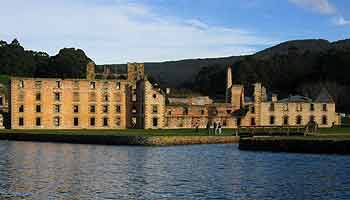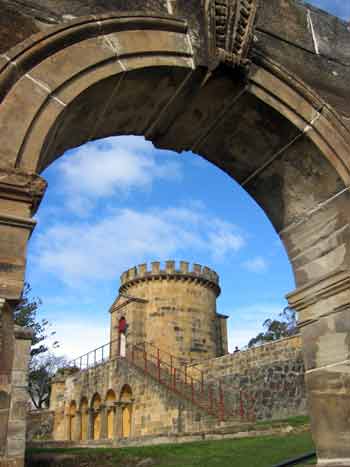Port Arthur - A Darkly Historic Site
14th June, Port Arthur, Tasmania, Australia
In 1927, the residents of a pretty town on the Tasman Peninsula decided that they wanted to change the town's name. There was nothing wrong with the name Carnarvon, but it was, perhaps, a little deceptive - an 'airbrush job', an attempt to cover up the past; evidently the residents did not want to sweep under the carpet a past that many would rather forget. That past was steeped in convict misdemeanour - Port Arthur was a prison settlement with no equal, a place with a harsh record of its treatment of prisoners, young and old. The old name had been dropped in 1884, just seven years after the settlement closed down. 13 years after that, the whole lot burned in a raging bush fire, leaving little to survive. But still there was no erasing the past.
These days, Port Arthur is the most-visited tourist attraction in Tasmania, and one of the most-visited in Australia as a whole. The buildings that survived the bush fire (not many, as most were made from timber) are, as a rule, the largest and most impressive brick buildings that stood there. None of them are more impressive than the penitentiary block. Once upon a time, it was a flour mill, but later converted to one of the largest lock-ups going. These days, all that's left is the brick shell - no roof, no interior to speak of - but it still makes for an impressive sight. Nearly all the promotional literature shows the same picture - Port Arthur Penitentiary reflected in the calm waters of Mason Cove. Here's our version (although the waters were not as calm or reflective as we'd like):

We took the guided walking tour, a 40-minute introduction and history lesson for the remaining buildings on the site, and soon after that boarded the MV Marana catamaran which took us out on to the cove, around the Isle of the Dead. Yes, a cheery name, isn't it? But it's also accurate - around 1,000 burials took place there, convicts and ex-convict paupers. It's a tiny island. They must have stacked them up a fair amount!
We looked at most of the buildings on the site, including the guard tower (offering a commanding view over the complex), the Commandant's House (1920s decoration, a bit whiffy!) and the convict church. The church has no name, nor any religion to speak of as it was never consecrated. It also has no roof, resembling a much scaled down version of Tintern Abbey.
The Guard Tower, Port Arthur Historic Site.
The last location we looked at was arguably the most chilling - the Broad Arrow Café. Before you think that this is leading to some kind of sarcastic joke about bad food or something, think again. In 1996, on a sunny Sunday afternoon, many other tourists were doing just what we were - taking photos, imagining the horrors of the past then having a sit down for a cup of tea and a couple of scones. Then the pleasant site-seeing was spoiled somewhat when a man walked into the café with a large blue bag, pulled a semi-automatic weapon out of it and began shooting. 20 people were killed there and then; by the end of the day 35 people in the area would die because of this lone gunman. Hadn't Port Arthur been the scene of enough horror? Apparently not: "A lot of violence has happened there. It must be the most violent place in Australia. It seemed like the right place," explained the perpetrator at his trial (guilty, no chance of parole).
Now, the Broad Arrow Café is just a shell, and next to it a memorial - the reflection pool. In it sits a sculpture consisting of 35 leaves. No matter how much the organisers try to recreate convict life in the 19th century, we'll never fully be able to imagine what it was really like; but what happened in 1996 seems far easier to imagine and, as a result, a lot more shocking.
The Reflective Pool - a memorial for those killed in 1996.
After visiting the historic site, we took a drive around the immediate area where there was more to see: the Remarkable Cave and Palmer's Lookout.
The Remarkable Cave was similar to the sea-sculpted formations we'd witnessed yesterday. What made this cave remarkable was firstly, there are two channels that come from the sea into the open-topped cave - a Y-shape. This is, according to the information board, a very rare thing. The second thing that made this remarkable was that from the ground, looking out through the tunnel to the sea, the shape at the end was an incredible likeness of the map of Tasmania. This was just a coincidence, of course but yesterday's straight-lined uniformity of the Tessellated Pavement and today's Tasmania-shaped rock tunnel made me wonder what oddity we might see tomorrow.
Oh, and Palmer's Lookout? Well, it's a lookout. Over Port Arthur and Safety Cove. And that's all I have to say on the matter (said Forrest Gump-style).

